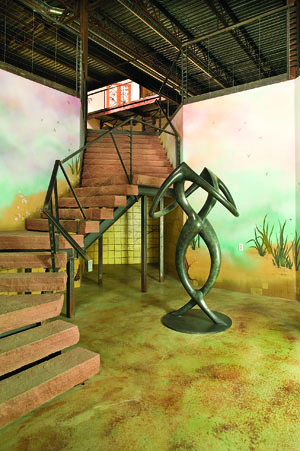Feature Garden: Paradise Regained
04 Jul 2007
This Louisville oasis overflows with verdant plants, sparkling fountains, tropical scents and the many paradisiacal elements of Eden.
It’s hard to believe that Richard and Myriam Doerr started with zilch when you look at their luxuriant landscape. Greenery greets you at every turn, jasmine and lavender perfume the air, cascading water sparkles in sunlight, and painted ceramic pots stuffed with tropical plants peek from all corners of their Louisville lot.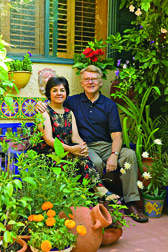 “I think it’s safe to say that every serious gardener strives to somehow re-create the Garden of Eden in his or her garden,” says Richard, who believes he’s “haphazardly groped” at that goal since he and Myriam moved to Colorado in 1975.
But “haphazard” doesn’t do his garden—or the many years of work he’s put into it—justice. After living in two Lafayette homes—and leaving both with gorgeous gardens for their new owners—the couple commissioned their dream home in 1990: a Spanish Colonial–style ranch to be built on a large corner lot in a new subdivision. Their new home proved to be the perfect inspiration to create a mini paradise. “We’ve traveled extensively,” Richard says, noting trips to Mexico, Chile, Argentina, Spain, Portugal, Italy, Turkey, Greece and Colombia, the last being Myriam’s birthplace. Those travels yielded plenty of handicrafts and novel ideas. “We knew we wanted to surround our house with the many elements and design ideas we’d encountered on our travels.”
“I think it’s safe to say that every serious gardener strives to somehow re-create the Garden of Eden in his or her garden,” says Richard, who believes he’s “haphazardly groped” at that goal since he and Myriam moved to Colorado in 1975.
But “haphazard” doesn’t do his garden—or the many years of work he’s put into it—justice. After living in two Lafayette homes—and leaving both with gorgeous gardens for their new owners—the couple commissioned their dream home in 1990: a Spanish Colonial–style ranch to be built on a large corner lot in a new subdivision. Their new home proved to be the perfect inspiration to create a mini paradise. “We’ve traveled extensively,” Richard says, noting trips to Mexico, Chile, Argentina, Spain, Portugal, Italy, Turkey, Greece and Colombia, the last being Myriam’s birthplace. Those travels yielded plenty of handicrafts and novel ideas. “We knew we wanted to surround our house with the many elements and design ideas we’d encountered on our travels.”
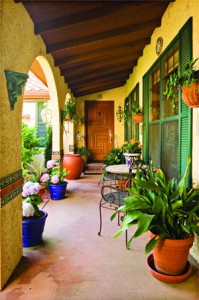 Thus began Richard’s quest to create his own Eden. But unlike the Bible’s six days of Creation, it took him several years. That’s still a wondrous achievement, especially when “not one living green thing was growing anywhere on our lot,” says Richard, who started landscaping it with his three sons a month after moving in. Common obstacles quickly became apparent, however. “Wherever we sunk a shovel it struck stone, not to mention compacted clay.”
So he and his boys hauled away tons of rocks, carried in acres of topsoil to build up the steeply sloping backyard and added copious amounts of soil amendments to break up the clay. After installing sprinklers, sod and a flagstone retaining wall to create two tiers in the backyard, the family’s “little oasis began to take shape.”
Thus began Richard’s quest to create his own Eden. But unlike the Bible’s six days of Creation, it took him several years. That’s still a wondrous achievement, especially when “not one living green thing was growing anywhere on our lot,” says Richard, who started landscaping it with his three sons a month after moving in. Common obstacles quickly became apparent, however. “Wherever we sunk a shovel it struck stone, not to mention compacted clay.”
So he and his boys hauled away tons of rocks, carried in acres of topsoil to build up the steeply sloping backyard and added copious amounts of soil amendments to break up the clay. After installing sprinklers, sod and a flagstone retaining wall to create two tiers in the backyard, the family’s “little oasis began to take shape.”
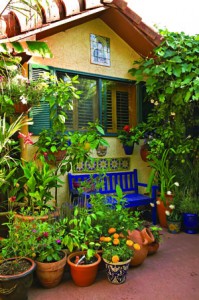 Next came the planting of paradise. Richard started with trees—lots and lots and lots of trees. Norway and red maples, sycamores, Niobe weeping willows, tulip trees, golden rain trees, Idaho locusts, Canadian redbuds, northern catalpas, Washington hawthorns, littleleaf lindens, Korean dogwoods, dwarf dogwoods, purple ash, a Kwanzan cherry, and several evergreens. Then he discovered more “exotic” trees: a fast-growing mimosa “that supposedly is hardy only to Zone 6, although it thrives in Zone 5,” a saucer magnolia, flowering quinces, a European medlar, a chaste tree “that turned into more of a bush,” a flowering almond and clumping bamboo.
After that, fruit trees: apple, peach, sweet cherry, apricot and pear. Next, shrubs: rhododendron, azalea, fragrant viburnum, hydrangea, mock orange, butterfly bush, forsythia and Korean lilac. Finally, flowers: 40 different roses, peonies, irises, delphiniums, foxtail lilies, trumpet lilies, Oriental lilies, daylilies, foxgloves, poppies, red-hot pokers, yarrow, echinaceas, dahlias, cannas, agapanthus, cladiums, calla lilies, hostas, and other annuals and perennials, interspersed with ornamental grasses and ferns.
Next came the planting of paradise. Richard started with trees—lots and lots and lots of trees. Norway and red maples, sycamores, Niobe weeping willows, tulip trees, golden rain trees, Idaho locusts, Canadian redbuds, northern catalpas, Washington hawthorns, littleleaf lindens, Korean dogwoods, dwarf dogwoods, purple ash, a Kwanzan cherry, and several evergreens. Then he discovered more “exotic” trees: a fast-growing mimosa “that supposedly is hardy only to Zone 6, although it thrives in Zone 5,” a saucer magnolia, flowering quinces, a European medlar, a chaste tree “that turned into more of a bush,” a flowering almond and clumping bamboo.
After that, fruit trees: apple, peach, sweet cherry, apricot and pear. Next, shrubs: rhododendron, azalea, fragrant viburnum, hydrangea, mock orange, butterfly bush, forsythia and Korean lilac. Finally, flowers: 40 different roses, peonies, irises, delphiniums, foxtail lilies, trumpet lilies, Oriental lilies, daylilies, foxgloves, poppies, red-hot pokers, yarrow, echinaceas, dahlias, cannas, agapanthus, cladiums, calla lilies, hostas, and other annuals and perennials, interspersed with ornamental grasses and ferns.
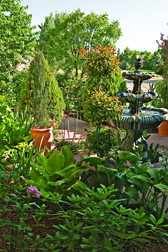 “Having grown up in Minnesota, where I was surrounded by lush greenery and water, water everywhere, I wished to replicate that to the extent it was feasible in semiarid Colorado,” says Richard, who teaches Spanish at Denver’s Metropolitan State College. But the more plants and artifacts he added to his garden, the more he realized it was clearly evolving into a “paradise garden,” particularly when he happened upon a book titled Paradise Gardens by Arnaud Maurières and Éric Ossart (Hachette Livre, 2001). “After years of trying to create a true oasis I had a revelation, so to speak, after reading it,” he says. “It tied together all the elements that, for me, constitute the perfect garden—the kind I had been striving to create.”
“Having grown up in Minnesota, where I was surrounded by lush greenery and water, water everywhere, I wished to replicate that to the extent it was feasible in semiarid Colorado,” says Richard, who teaches Spanish at Denver’s Metropolitan State College. But the more plants and artifacts he added to his garden, the more he realized it was clearly evolving into a “paradise garden,” particularly when he happened upon a book titled Paradise Gardens by Arnaud Maurières and Éric Ossart (Hachette Livre, 2001). “After years of trying to create a true oasis I had a revelation, so to speak, after reading it,” he says. “It tied together all the elements that, for me, constitute the perfect garden—the kind I had been striving to create.”
Midpoint of Paradise
The paradise garden is foremost a Mediterranean garden, similar to those that arose thousands of years ago in Middle Eastern deserts. Present-day examples include the Orange Tree Courtyard—or Patio de los Naranjos—in Córdoba, Andalucía, Spain, and the world’s most well-known paradise garden, the Alhambra’s Generalife gardens in Granada, Spain. Conquering Muslims from North Africa enhanced the Mediterranean’s first paradise gardens—planted by Jewish and Christian gardeners—by filling them with exotic fruits and flowers from faraway Persia, India and China. These gardens also borrowed flourishes from Greek and Roman cultures, and architectural elements from the old civilizations of Persia, Baghdad, Damascus and Kashmir. “In fact,” Richard says, “the word ‘paradise’ is derived from the ancient Persian word pairidaeza, which was an enclosed oasis separated from the noisy, dusty world outside its walls.”
Although walls do not enclose the Doerrs’ paradise, long rows of fruit and juniper trees encircle it. And the scent of gardenia, Arabian jasmine, heliotrope, Peruvian daffodil, lavender and Abyssinian lily perfume it. “I endeavored to bring together not so much the ideal and original layout of the paradise garden as I did the elements that appeal to all the senses,” Richard says. One of those is water. “According to Islamic tradition, it’s the single most important element of eternal renewal and ‘the symbol of God’s mercy,’” he says.
In addition to the large fountain that graces the home’s entrance, Richard installed a wall fountain and a pond in the backyard, along with a birdbath. “The sound of splashing water always attracts songbirds,” Richard says. “To ours come house finches, lesser goldfinches, blue jays, chickadees, downy woodpeckers and hummingbirds.”
But no paradise is complete without tropical plants. Richard puts his in pots that he drags indoors to an adjacent sunroom before the first frost. Palm and fig trees, flowering bougainvilleas and passionfruit vines are just some of the many tropical plants in the Doerrs’ garden.
“In fact,” Richard says, “the word ‘paradise’ is derived from the ancient Persian word pairidaeza, which was an enclosed oasis separated from the noisy, dusty world outside its walls.”
Although walls do not enclose the Doerrs’ paradise, long rows of fruit and juniper trees encircle it. And the scent of gardenia, Arabian jasmine, heliotrope, Peruvian daffodil, lavender and Abyssinian lily perfume it. “I endeavored to bring together not so much the ideal and original layout of the paradise garden as I did the elements that appeal to all the senses,” Richard says. One of those is water. “According to Islamic tradition, it’s the single most important element of eternal renewal and ‘the symbol of God’s mercy,’” he says.
In addition to the large fountain that graces the home’s entrance, Richard installed a wall fountain and a pond in the backyard, along with a birdbath. “The sound of splashing water always attracts songbirds,” Richard says. “To ours come house finches, lesser goldfinches, blue jays, chickadees, downy woodpeckers and hummingbirds.”
But no paradise is complete without tropical plants. Richard puts his in pots that he drags indoors to an adjacent sunroom before the first frost. Palm and fig trees, flowering bougainvilleas and passionfruit vines are just some of the many tropical plants in the Doerrs’ garden.
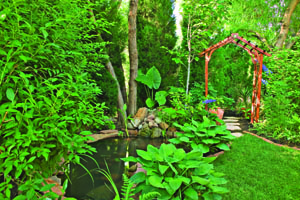 It wasn’t easy creating paradise, but it was well worth it, says Richard, who describes his as “a little bit of Moorish Andalucía.” And though Myriam wholeheartedly enjoys the fruits of their sanctuary, she quickly gives credit where credit is due: “It’s all Richard’s work,” she says of their garden. “I bring him lemonade, that’s all.”
It wasn’t easy creating paradise, but it was well worth it, says Richard, who describes his as “a little bit of Moorish Andalucía.” And though Myriam wholeheartedly enjoys the fruits of their sanctuary, she quickly gives credit where credit is due: “It’s all Richard’s work,” she says of their garden. “I bring him lemonade, that’s all.”
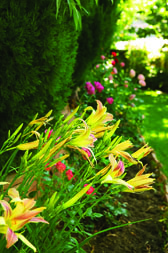 Something Richard no doubt appreciates during respites from tending paradise. “In summer,’ he says, “as we sit in our oasis, surrounded by greenery, water, colors, scents, shadows, sunlight, trees, flowers, birds, and decorative tiles, ironwork and Moroccan lanterns, it’s no wonder sacred texts always describe Paradise as a garden.”
Indeed.
Carol Brock is editor of Boulder County Home & Garden Magazine and a firm believer in paradise on Earth.
Something Richard no doubt appreciates during respites from tending paradise. “In summer,’ he says, “as we sit in our oasis, surrounded by greenery, water, colors, scents, shadows, sunlight, trees, flowers, birds, and decorative tiles, ironwork and Moroccan lanterns, it’s no wonder sacred texts always describe Paradise as a garden.”
Indeed.
Carol Brock is editor of Boulder County Home & Garden Magazine and a firm believer in paradise on Earth. 

